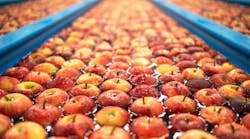To satisfy Americans’ growing appetite for organic food, processors have a role to play right alongside farmers.
Organic food sales have climbed steadily for at least the past 10 years, from $25.2 billion in 2011 to $56.5 billion in 2020, according to the Organic Trade Assn. 2020 saw a leap of 12.8%, which OTA officials attributed to the pandemic – and the growth could have been bigger if there had been more to sell.
“The only thing that constrained growth in the organic food sector was supply,” Angela Jagiello, the OTA’s director of education and insights, said in a statement on the organization’s website. “Across all the organic categories, growth was limited by supply, causing producers, distributors, retailers and brands to wonder where numbers would have peaked if supply could have been met!”
The supply situation originates with farmers, of course, but it has implications for processing as well. Organic processing presents certain challenges within the walls of a processing plant, especially one that handles non-organic product as well – which most of them do.
To make products that can carry the USDA’s organic seal, plants must have certification from the USDA’s National Organic Program (NOP), which encompasses every aspect of operation, or an equivalent international program. (See To Certify Product, First Certify the Plant sidebar below)
Getting NOP certification is just the first of ongoing challenges in organic operation. One of the biggest stems from the fact that organic ingredients are relatively rare and expensive. Farmers have to invest up to three years in getting acreage up to organic standards, during which time they have to endure lower yields that they can’t sell at the higher organic price.
The situation creates a temptation to cheat that some find overwhelming, as in the case of a Missouri farmer and grain broker who misrepresented more than 11.5 million bushels of corn and soybeans as organic over a seven-year period (and who committed suicide after being sentenced to 10 years in federal prison).
This situation is why fraud in organic ingredients is considered a major processing challenge, especially when they’re sourced overseas. The OTA has an entire program dedicated to organic fraud prevention, which spells out how processors can implement a fraud detection plan and offers opportunities to connect with OTA-certified “Trusted Advisors” to combat fraud. The advent of tracing technologies like blockchain make verification easier.
“One of the requirements of the organic program is that you must be able to trace finished goods back to the receiving of the raw ingredient(s),” says Shannon Murphy, a consultant with The Organic Consulting Firm, an organic certification agency. “So tracking is a very important part of organic certification.”
Consistently inconsistent
Even without any question of cheating, organic ingredients can be challenging in their lack of consistency, in both supply and quality. The latter is less of a concern now that it used to be, says consultant Gary Seiffer.
“A lot of the times, organic foods at the beginning were not as consistent,” Seiffer says. The protein content of flour made from organic wheat, for instance, might vary from 8% to 14%. However, the increasing popularity of organic foods is motivating ingredient suppliers to become more consistent with the quality of their goods, Seiffer and others observers say.
To Certify Product, First Certify the Plant
For food plants to produce USDA-certified organic products, the plants themselves must be certified under the USDA’s National Organic Program.
Broadly speaking, NOP certification requires that a plant be able to attest that each step in its process conforms to organic standards, and to identify where in the process those standards are liable to be compromised. The certification has to be done by an accredited third-party auditor.
Processors must develop an Organic Systems Plan (OSP), says Shannon Murphy, a consultant with The Organic Consulting Firm, an organic certification agency.
“The OSP identifies how a company will protect the organic integrity of the ingredients and final products from contamination and comingling,” Murphy says. “The areas typically reviewed include receiving, storage, production, packaging, labeling [and] pest control.”
Processors must also be able to furnish proof that their ingredients were sourced from organic suppliers, and that their formulations have at least 95% organic makeup by weight or liquid volume.
Organic certification is an ongoing process that has to be renewed annually, says Stephanie Leahy, certification team lead, MOSA (Midwestern Organic Services Assn.) Certified Organic.
“Each operation/processor must go through an annual inspection and review of their production and recordkeeping systems in order to verify continued compliance with the standards,” she says. Processors also must pay an annual fee to the USDA.
That increasing popularity, though, is leading to another problem: inconsistent supply. Demand for organic food has made ingredients tough to come by in some cases, especially for processors who are just starting out.
That’s why some processors take what might be seen as an extreme step: owning the fields, orchards or wherever the ingredients they need are grown or produced. Seiffer recalled a baker in Maine who, frustrated at not being able to find organic flour in the quantities he needed, bought his own wheat field.
In the case of AYO Yogurt, that process was, so to speak, inverted. The Billings family has owned organic almond orchards in California for generations. A few years ago, they started looking for a way to create a market for their crop. Almond milk is a saturated market, and almond butter a niche one, but after tasting some existing almond yogurts, they decided that they could do better, says Phil Gruszka, AYO Yogurt’s operations manager.
AYO was rolled out about a year and a half ago. The timing proved perfect, as the pandemic inspired some consumers to try healthier eating. The almond-based yogurt now is distributed throughout California, with some inroads into the Midwest and the East Coast.
AYO declares on its label that it’s “made with organic almonds,” but the product itself can’t be called organic just yet. According to FDA regulations, a product must have 95% organic ingredients to be called organic, and AYO doesn’t currently meet that threshold. The problem is the inulin, derived from chicory root, that’s in the formulation to add fiber.
AYO hasn’t been able to source organic versions in sufficient quantities, Gruszka says, but he adds: “We’re really close; we’re getting closer all the time.”
AYO uses a contract manufacturer in the Los Angeles area that specializes in yogurt. AYO’s ingredients are handled in a dedicated area, free of cross-contamination from either dairy or non-organic materials. “They’ll run at the beginning of the day after everything’s been cleaned,” Gruzska says. He isn’t sure whether the co-packer currently uses equipment dedicated to organic or non-dairy yogurt, but says that it’s moving in that direction due to increased processing of non-dairy.
Photo: JBT Corp
Getting crossways
Cross-contamination is a major issue in organic food processing. Most plants that produce organic food also process non-organic; in many cases, not even the equipment is dedicated.
“The greatest challenge typically seen in organic and natural product production is cross-contamination,” says Juan Martinez, global product line manager for equipment supplier JBT Corp. “Most companies and producers competing in this market don’t have a single line of machinery and equipment dedicated to this production.”
If machinery is to be used for both organic and non-organic product, it should be designed for quick yet thorough cleaning, ideally by clean-in-place systems where possible.
Contamination, whether by non-organic ingredients or other sources, is a source of concern for areas besides processing lines. “A split operation running both organic and nonorganic products will need to keep documentation of each cleaning prior to running organic production, and needs to have organic ingredients stored and labeled without potential for commingling,” says Stephanie Leahy, certification team lead, MOSA (Midwestern Organic Services Assn.) Certified Organic.
Contact with non-organic product is not the only source of potential contamination. “If they are importing bulk organic grains there are many control points to measure and monitor from phytosanitary concerns to contamination due to unclean transport units,” Leahy says.
Pests are especially liable to be vexing in organic operations. Organic grain and other ingredients, which must be grown without pesticides, are more susceptible to infestations. Once these occur, anti-pest measures must not use chemicals that are proscribed for organic plants.
Similarly, sanitizing chemicals have to be compatible with organic standards. These are distinguished from cleaning chemicals, which are applied, then rinsed off; if they are properly rinsed, there should be no possibility of product contact.
Sanitizers are biocides intended to be applied to a clean surface. Most of the time they’re not rinsed, but in an organic operation, certain ones require rinsing or some kind of “intervening step,” according to USDA standards. These include acetic acid, ethyl alcohol and quaternary ammonia.
Organic operations are not easy, nor are they intended to be. Organic status goes to the core of what a product – a company – is all about, and that includes the details of what goes on inside its plants.
“It would be a lot easier if you were non-organic, because from a fruit standpoint, from a stabilizer standpoint, from a shelf-life standpoint, everything can be elongated. But it doesn’t ring true to what we’re all about,” says AYO Yogurt’s Gruszka. “It’s certainly not as easy, and it’s more expensive to do what we’re doing, but it really is something that we wanted to do, and we wanted to stay true to what we’re all about.”


